Disabilities don’t stop these experts in science and tech
From blowing things up to listening to bugs, there’s a STEM career for everyone
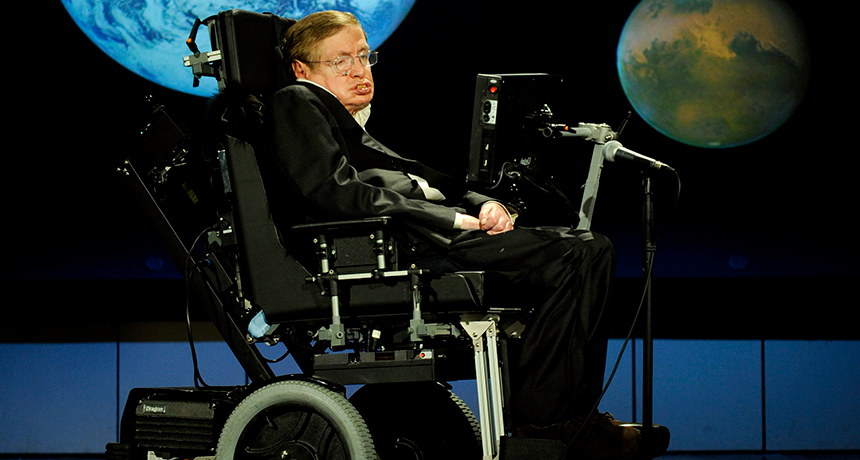
Theoretical physicist Stephen Hawking is probably the most famous scientist with a disability, but he’s far from alone. Meet some of the many other scientists and engineers who have hurdled physical or medical barriers to find rewarding careers in research.
Paul E. Alers/NASA
As a combat engineer in the U.S. Marine Corps in 2011, Neil Altomare’s job was to detect unexploded home-made bombs known as IEDs, or improvised explosive devices. Many were hidden throughout Afghanistan’s Sangin Valley, where he was deployed. Once he found an IED, Altomare would destroy it — often by blowing it up. This work helped keep his fellow Marines safe.
But neither his equipment nor visual scans could detect all hidden bombs. And one day, Altomare stepped on an IED. He survived. But the explosion destroyed his right leg below the knee. Shrapnel hit him almost everywhere else. Yet despite the pain and injuries, he was able to direct rescue troops to carry him along a safe path out of the field and to the helicopter that would airlift him to medical care.
Dozens of surgeries followed. More than a year later, Altomare was back home in Albuquerque, N.M. There he learned about the Wounded Warrior career program. And that led to a job in town at Sandia National Laboratories. Today, he’s part of its environmental safety and health team. And he works with explosives. “I had worked with explosives in the military,” he notes, “and I wanted to continue that.” Some of his work helps the military. Other work can protect civilians.
His job falls within a broad field known as STEM. Its short for science, technology, engineering and math. These research disciplines attract all types of women and men. They may be young or old, short or tall, come from any nation and sport skin of any color.
Some, like Altomare, also have to deal with a serious physical or mental challenge. They may have lost limbs or walk on crutches. They may be blind or deaf. Some may even be hobbled by “hidden” disabilities — challenging medical conditions that may not be outwardly visible. Yet any and all may perform important work in their fields.
Most people have heard about the achievements of British mathematician and physicist Stephen Hawking, now 75 years old. At age 21, he developed a debilitating nerve-and-muscle disease — amyotrophic lateral sclerosis. Within another six or so years, he was wheelchair-bound. Hawking has long needed help from a voice synthesizer to speak. Yet over the past decades, none of this kept him from making major advances in cosmology — the study of our universe. He is an exceptional scientist.
But he’s not alone. Many more contribute mightily to their research fields. You may not know their names — yet. But that doesn’t diminish what they can and do contribute.
In the United States alone, more than half a million people in STEM fields have some form of disability. But as with most researchers, these scientists, engineers and mathematicians tend to toil away largely outside the public eye. Their disabilities don’t define them. In many cases, their personal challenges may even spur them to tackle problems in a novel way — one that ups the chance they’ll find a solution.
Here we meet a few of them.
Story continues below video.
Listening to space
As a little girl, Wanda Diaz Merced loved to look up at the stars from her home in Gurabo, Puerto Rico. She now is an astronomer at the International Astronomical Union’s Office of Astronomy for Development in Cape Town, South Africa. But Merced can no longer see the stars. She lost her eyesight as a young adult from problems associated with diabetes.
Until she went blind, Diaz Merced used charts and graphs to help her study space phenomena, such as gamma ray bursts. These are very-high-energy explosions in distant galaxies. The charts and graphs she had used were based on numbers. And one day it dawned on her that she didn’t need to see those numbers to delve into the data they held. She could simply express the numbers as sounds.
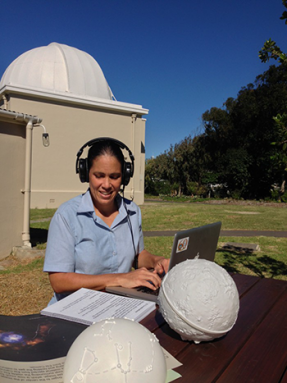
Working with other researchers in the United States and Scotland, Diaz Merced developed a new way to study space. It’s called sonification (SAHN-ih-fih-KAY-shun). A computer converts data from space into sounds. The data points become tones with different pitches, frequencies and volumes. To the untrained ear, those tones may sound like clicks, chimes, beeps or even music. But to Diaz Merced, they’re data that she can interpret.
Consider a star system where two stars — a white dwarf and a red giant — orbit each other. They regularly eclipse each other, meaning one briefly blocks the other’s light. In a sound clip, the tones start out low and increase to a maximum. Then they return to low tones.
“The first low tones correspond to the time when the white dwarf is eclipsing the red giant,” Merced explains. The highest tones represent when the stars are side by side. That’s when the maximum amount of their energy — light — is detected. The later low tones, she explains, reflect when the red giant is eclipsing the white dwarf.
Sonification lets Merced do advanced physics. But her technology could aid others in her field as well. “You see better when you use sound,” she argues. In astronomy, some events happen in a very short timeframe. Sound might help researchers detect those events. Or it might help to cut through visual “noise” that can make it hard to distinguish details. Sound, she maintains, can help ensure important data won’t be lost in that noise.
The technique has helped Diaz Merced detect shifts in light from variable stars. These are suns whose brightness changes on time scales ranging from seconds to years. Even dim variations in light can sometimes be very important, she notes. Computer processing of satellite data can make tiny changes hard to detect. Sound, she says, can boost your sensitivity to subtle events.
Losing her eyesight was a big stumbling block. But looking back, Diaz Merced now says, “the main barrier was my mind.” Fortunately, she had good mentors — people who coached her and helped her advance.
“Never give up,” she now tells students. “Even if you did not get the grades you expected this year, the only thing that matters is your determination. Please never give up on your dreams!”
Fighting pests
As a boy in New Mexico, Richard Mankin wondered why insects could fly and he couldn’t. Indeed, he recalls, “I always kind of wanted to fly.” Now as an entomologist in Gainesville, Fla., he studies insects for the federal government. He works for the Agricultural Research Service, part of the U.S. Department of Agriculture, or USDA.
Mankin still can’t fly — at least not without a plane. In fact, a rare muscle disease means he finds even walking hard. To get around, Mankin wears leg braces and uses two crutches. But that doesn’t stop him from getting into the field to listen for bugs.
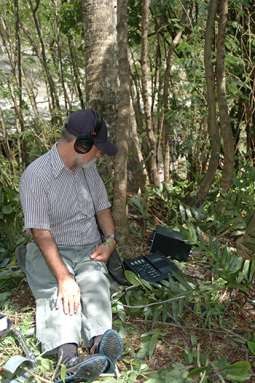
He focuses on sounds most of us will never hear. He scouts for hidden infestations of insects, he explains. With electronic equipment, he listens for the chomping sounds that bugs make in wood, soil or stored products.
Mankin’s disability played an indirect role in his career path. “I really started off in physics,” he says. But opportunities for people with disabilities seemed limited when he was in college. Then he got a chance to work at USDA in an insect research lab. He realized “there were just a lot of physics tools that you could apply to questions of entomology.” Moreover, he notes, “Nobody else was doing it.” Before long, he was hooked.
Since turning to entomology — the study of bugs — Mankin has helped to develop equipment that can listen in on insects feeding on a tree. Their chomping sounds make the wood vibrate, somewhat like a violin string. Pressure vibrations from the sound hit a piezoelectric (Pee-AY-tzoh-ee-LEK-trik) crystal in his tool. The crystal develops a voltage when squeezed. And the vibrations in the wood make the crystal alternately squeeze and release. The strength and frequency of voltage changes in the crystal let Mankin and others measure the sound of the munching insects.
Mankin’s research has taken him across the United States. He also has done work in other countries. Often he teams up with biologists to listen for insects. Sometimes those other scientists will assist him. “I’m good on operating the equipment,” he notes, but “I’m not good at climbing trees.”
Insights from animals
“If you were to see me in person, I doubt that you would look at me and immediately recognize that I have some kind of physical disease,” notes Naomi Ondrasek. She’s a biologist at the University of California, Davis. There, she studies how the brain and hormones affect animal behavior. When she’s not working, Ondrasek plays with her children, hikes, dances and plays the ukulele. She also enjoys reading, especially American literature from the mid-19th century.
But autoimmune disease often plagues this scientist. The immune system is designed to fight off disease. Sometimes, though, the body mistakes its own tissue for an invader. Then it may begin attacking its own tissues. Some cases are mild. Ondrasek’s can be devastating.
One of her conditions is a type of inflammatory bowel disease, or IBD. Its range of symptoms includes frequent diarrhea. A new bout could hit any day. But Ondrasek notes that with each flare-up, “It’s not just that you have to go to the bathroom a lot.” There’s also intense pain. Sometimes she has energy for nothing but trying to make it through that pain.
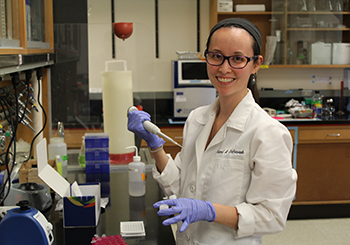
“It feels like you’ve swallowed a ninja star,” she says. “It feels like you’ve swallowed broken shards of glass.” Ondrasek can’t sleep at night when the pain is that bad. For the moment, though, she says, “I feel great. I feel borderline normal.”
Ondrasek doesn’t let her health issues detract from her work. “The big question I ask,” she says, is “Why do animals get into social groups?” Among people, social relationships are incredibly important to well-being. That’s also true, she notes, for some other species.
One of her projects reviewed research on certain chemicals produced by the brain. There are several types of these nonapeptides (NO-nah-PEP-tydes). They are tiny protein-like chains of nine (hence the prefix nona-) amino-acid bits. These chemicals can circulate in blood, controlling processes throughout the body. A well-known example is oxytocin (OX-ee-TOH-sin). It helps control when mammals give birth and produce milk for their young.
When oxytocin and other nonapeptides act in the brain, they can influence social behavior, she explains. For instance, oxytocin can provide a sense of love or trust in another person, such a baby or mate. And because so many species produce virtually the same chemicals, Ondrasek says, “things that we discover in rodents and even birds … help us as we look at these behaviors in humans.” Her June 2016 report reviewing all of this appeared in Ethology.
Ondrasek notes that “Though I have all these health issues, I was able to persist in my career.” She is thankful for supportive academic advisors and coworkers. By law, employers usually must make reasonable efforts to help employees with disabilities. Yet for her employer to understand her particular needs, she notes, “I have to be very willing to share something that’s very intimate and potentially embarrassing.”
Ondrasek has been fortunate to work with very positive, supportive people who don’t focus on her disability. Ideally, she notes, all employers and potential colleagues will one day see such accommodations as no big deal, akin to providing office lighting and heating to workers on dark winter days.
Protecting a river
Caroline Solomon was on her high school’s swim team. But at times she could not go into the creek near her home. It was simply too polluted. “I decided I wanted to do something about it,” she recalls. So she studied environmental science and public policy at Harvard University in Cambridge, Mass. Later, she went to graduate school. Some of her classes could be challenging, though, since she couldn’t hear her teachers. “I’ve been deaf since I was 15 months old,” Solomon notes.
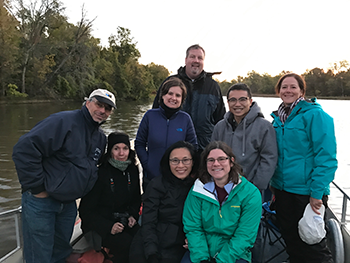
Today she teaches biology at Gallaudet University in Washington, D.C. She has no trouble communicating with her students. They, too, are primarily deaf or hard of hearing. That’s why all classes at Gallaudet are taught in American Sign Language. Solomon also has an active life outside the classroom. She especially enjoys hiking, biking and other activities with her family.
Her research takes her to the Anacostia River. “It is very close to Gallaudet, and I easily bring my students there,” she says. Water running through local forests and marshes drains into this river. So does water running off of urban streets, golf courses and industrial sites. The river’s watershed “kind of concentrates all the things that happen when humans mess with the natural landscape,” she explains. Not surprisingly, this river has developed a reputation for being quite polluted.
Solomon has been focusing on how pollutants affect tiny organisms that form the base of the river’s food web. “I am now looking at the cyanobacteria population,” she says, “to see what types are there.” Also known as blue-green algae, these potentially toxic organisms can bloom — grow out of control — if they’re fed by too many nutrients. And the fertilizers in rainwater running off of lawns, fields and other sites can fuel their runaway growth. When a bloom later dies back, bacteria will feast on the remains. That can use up much of the oxygen in the water.
Solomon wants to see more students who are deaf or have other disabilities make a difference in environmental science and other fields. As she often says, “If I can do it, you can do it.”
‘I get to blow things up’
Neil Altomare chooses to work with explosives, despite his war injury. After all, “I get to blow things up,” he says. “I’m…kind of a little kid. And it’s still fun.”
However, safety must come first. “When you deal with explosives yourself, you know what’s safe and unsafe,” he says. Ultimately, his work helps make life safer for both civilians and people in the armed forces.
Often his group designs and builds areas to test explosives. Everything requires checking and double-checking. And each trial takes careful planning. In college, he studied management information systems. That field uses technology-based tools to collect data, organize them and then use them to make informed decisions. And it helps him now.
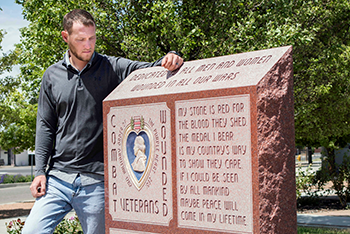
“I’m in charge of all of the people on site during the tests. I’m in charge of all of the equipment used during the tests.” That includes pricey high-speed cameras and data-recording equipment. “And essentially I’m in charge of the results along with the engineer after the test is done,” he explains.
Altomare’s injury means he now needs to rely on a prosthetic lower leg. But because he wears jeans a lot, it isn’t obvious. And that’s fine with him, because being an amputee is not what he or his job is about, he explains.
The proud dad of a toddler, Altomare thinks a lot about the next generation. He hopes all young people pursue their dreams, regardless of any physical or other limitation.
“Don’t call it a disability,” he says. “Don’t let anyone tell you that just because of something that’s ‘wrong’ with you, it should limit your education or limit your experience in life. We’re the only ones that can put limitations on ourselves.”
This is the second in a two-part Cool Jobs series on the value of diversity in science, technology, engineering and mathematics. It has been made possible with generous support from Arconic Foundation.







